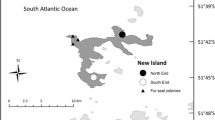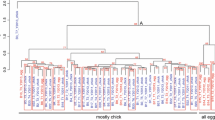Summary
This paper describes some spatial foraging strategies observed in the course of the breeding season in five adult radio-tagged black-headed gulss (Larus ridibundus).
-
1.
Individual foraging distances increased continuously during the nesting period.
-
2.
The maximum foraging distance observed was 18.5 km.
-
3.
All birds showed nearly constant flight directions over the whole breeding period.
-
4.
It is suggested that the continuous increase in foraging distances reduces intraspecific competition around the colony.
-
5.
Because of long foraging distances it seems to be advantageous to use only a small constant foraging sector. This behaviour can probably optimize spatial memory and enhance energetic and temporal efficiency.
Similar content being viewed by others
References
Birkhead TR, Furness RW (1985) Regulation of seabird populations. In: Sibly RM, Smith RH (eds) Behavioural ecology. Blackwell Scientific Publications, Oxford, pp 145–167
Bradbury JW, Vehrencamp SL (1976) Social organization and foraging in emballonurid bats. II. A model for the determination of group size. Behav Ecol Sociobiol 1:383–404
Cook DC (1978) Grey herons (Ardea cinerea) holding feeding terretories on the Ythan estuary. Bird Study 25:11–16
Cuendet G (1979) Etude du comportement alimentaire de la mouette rieuse (Larus ridibundus L.) et de son influence sur les peuplements lombriciens. Thèse de doctorat, Universitée de Lausanne
Custer TW, Osborn RG (1978) Feeding habitat use by colonially-breeding herons, egrets, and ibises in North Carolina. Auk 95:733–743
Davis JWF, Dunn EK (1976) Intraspecific predation and colonial breeding in lesser black-backed gulls Larus fuscus. Ibis 118:65–77
Fagerström T, Moreno J, Carlson A (1983) Load size and energy delivery in birds feeding nestlings: constraints on and alternative strategies to energy-maximization. Oecologia (Berlin) 56:93–98
Hamilton JW III, Gilbert WM, Heppner FH, Planck RJ (1967) Starling roost dispersal and a hypothetical mechanism regulating rhythmical animal movement to and from dispersal centers. Ecology 48:825–833
Hartwig E, Hüppop O (1982) Zum Energie- und Nahrungsbedarf einer Kolonie der Lachmöwe (Larus ridibundus L.) and der Schlei. Seevögel, Zeitschrift des Verein Jordsand, Hamburg, Sonderband: 93–105
Hunt GJ Jr (1972) Influence of food distribution and human disturbance on the reproductive success of herring gulls. Ecology 53:1051–1061
Mace GM, Harvey PH, Clutton-Brock TH (1983) Vertebrate home-range size and energetic requirements. In: Swingland IR, Greenwood PJ (eds) The ecology of animal movement. Clarendon Press, London, pp 32–53
Morris RD, Black JE (1980) Radiotelemetry and herring gull foraging patterns. J Field Ornithol 51:110–118
Morris RD, Hunter RA (1976) Monitoring incubation attentiveness of ground-nesting colonial seabirds. J Wildl Manage 40:354–357
Olton DS, Handelmann GE, Walker JA (1981) Spatial memory and food searching strategies. In: Kamil AC, Sargent TD (eds) Foraging behavior. Ecological, ethological and psychological approaches. Garland STPM Press, New York London, pp 333–354
Palokangas R, Hissa R (1971) Thermoregulation in young blackheaded gull (Larus ridibundus L.). Comp Biochem Physiol 38A:743–750
Pratt HM (1980) Directions and timing of great blue heron foraging flights from a California colony: implications for social facilitation of food finding. Wilson Bull 92:489–496
Schmidtke K (1975) Die Brutkolonien der Lachmöwe Larus ridibundus im Rußweihergebiet bei Eschenbach/Opf. Anz orn Ges Bayern 14:237–260
Tucker VA (1972) Metabolism during flight in the laughing gull, Larus atricilla. Am J Physiol 222:237–245
Van Vessem J, Draulans D, DeBont AF (1984) Movements of radio-tagged grey herons (Ardea cinerea) during the breeding season in a large pond area. Ibis 126:576–587
Wittenberger JF, Hunt GL Jr (1985) The adaptive significance of coloniality in birds. Avian Biology VIII:1–78
Author information
Authors and Affiliations
Rights and permissions
About this article
Cite this article
Gorke, M., Brandl, R. How to live in colonies: spatial foraging strategies of the black-headed gull. Oecologia 70, 288–290 (1986). https://doi.org/10.1007/BF00379253
Received:
Issue Date:
DOI: https://doi.org/10.1007/BF00379253




